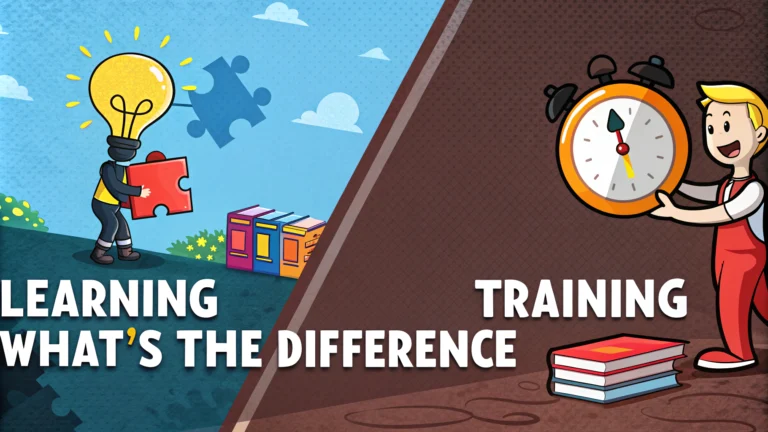The terms learning and training get mixed up often in professional settings. While they both relate to acquiring knowledge and skills, they serve different purposes and follow distinct approaches.
Understanding these differences helps organizations and individuals make better choices about professional development programs. It also guides instructional designers and HR professionals in creating more effective educational strategies.
Core Differences Between Learning and Training
- Learning is self-directed, continuous, and driven by curiosity
- Training is structured, goal-oriented, and focused on specific outcomes
| Learning | Training |
|---|---|
| Self-paced | Scheduled |
| Exploratory | Structured |
| Long-term focus | Short-term goals |
When to Choose Learning Over Training
- Personal skill development
- Career exploration
- Knowledge building in broad subject areas
- Long-term professional growth
Effective Training Program Components
- Clear objectives and measurable outcomes
- Structured lesson plans
- Regular assessments
- Practical exercises
“Training tells you how; learning helps you understand why.” – Peter Senge
The Strategic Value of Learning and Training Programs
Learning and training serve distinct purposes in professional development, each with unique approaches and outcomes. Understanding when to use each method helps organizations and individuals create more effective growth strategies.
Integrating Learning and Training Successfully
Combining both approaches creates a comprehensive development strategy that addresses immediate needs while supporting long-term growth. **Blended learning** programs merge structured training with self-directed exploration.
- Use training modules for core skills
- Support with learning resources for deeper understanding
- Create peer learning groups
- Implement mentorship programs
Digital Tools and Platforms
Modern technology offers various solutions to support both learning and training initiatives.
| Purpose | Recommended Tools |
|---|---|
| Skill Training | LinkedIn Learning, Udemy |
| Knowledge Sharing | Slack, Microsoft Teams |
| Assessment | Kahoot, Quizlet |
Measuring Progress and ROI
Track success through specific metrics aligned with program objectives.
Training Metrics:
- Completion rates
- Assessment scores
- Skill application rates
- Time to competency
Learning Metrics:
- Knowledge retention
- Project outcomes
- Innovation rates
- Career progression
“What gets measured gets managed. What gets managed gets improved.” – Peter Drucker
Creating Your Development Strategy
Select the right approach based on your specific goals and circumstances.
- Assess current skills and knowledge gaps
- Define clear objectives for improvement
- Choose appropriate learning or training methods
- Set realistic timelines
- Monitor progress regularly
A well-designed combination of learning and training activities creates lasting impact on professional growth and organizational success. Focus on matching methods to specific needs while maintaining flexibility for changing requirements.
FAQs About Learning vs Training
What is the main difference between learning and training?
Learning is a self-directed process of acquiring knowledge and understanding, while training is a structured, instructor-led activity focused on developing specific skills or competencies.
Why is workplace learning different from workplace training?
Workplace learning happens continuously through:
- Daily experiences
- Peer interactions
- Problem-solving
- Self-study
While workplace training is formal, scheduled, and designed to meet specific organizational goals.
Which is more effective: self-paced learning or structured training?
Both serve different purposes:
| Self-paced Learning | Structured Training |
|---|---|
| Better for theoretical knowledge | Better for practical skills |
| Flexible timing | Consistent outcomes |
How do learning outcomes differ from training objectives?
Learning outcomes are broader and focus on understanding concepts, while training objectives are specific, measurable goals tied to performance improvement.
What role does technology play in learning vs training?
Technology supports both through different tools:
- Learning: Knowledge bases, wikis, forums
- Training: LMS systems, virtual classrooms, simulation software
How do companies measure ROI on learning versus training programs?
Training ROI is measured through specific performance metrics, while learning ROI often shows in long-term employee development and innovation.
Can employee onboarding include both learning and training?
Yes, effective onboarding combines:
- Structured training for job-specific skills
- Learning opportunities about company culture
- Self-paced knowledge acquisition
What are the costs associated with learning vs training programs?
Training typically has higher upfront costs for:
- Instructors
- Materials
- Facilities
While learning resources often require lower but ongoing investment.
How does remote work impact learning and training approaches?
Remote work has led to:
- Increased digital learning platforms
- Virtual training sessions
- Hybrid learning-training models
What skills are better acquired through learning vs training?
Learning is better for:
- Critical thinking
- Problem-solving
- Creative skills
Training is better for:
- Technical skills
- Standardized procedures
- Compliance requirements



















